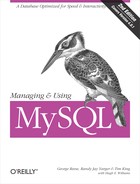The Connection
An application
should call mysql_init(
)
before performing any other
operation. This method initializes a database handler used by many of
the functions—including the connection and
error
handling functions. In the above example, we created a handler in the
declaration:
MYSQL *connection, mysql;
The pointer to the handler, connection, will
represent our actual connection once it is made; the allocated
handler, mysql, represents a null connection until
we actually make the database connection. Our first step is to
initialize this handler through the mysql_init( )
function:
mysql_init(&mysql);
This function takes a reference to an allocated
null handler. The MySQL API
requires this hocus-pocus with a null handler to support operations
such as error handling that occur outside the context of a physical
database connection. The first function needing this handler is the
actual connection API: mysql_real_connect( ).
Tip
At first glance over the API list, you may be tempted to use the
mysql_connect( ) function. The odd name of the
mysql_real_connect( ) function exists because it
is a replacement for the long-deprecated mysql_connect(
) function. The old mysql_connect( )
provided compatibility for mSQL applications; you should never use it
in modern applications.
The mysql_real_connect(
)
function takes several arguments:
- null handler
The connection handler allocated and subsequently initialized through
mysql_init( ).- host
The name of the machine on which the MySQL server is running.
- user
The user ID of the MySQL user to connect under.
- password
The password that identifies the user you are connecting under.
- database
The name of the database on the MySQL server to connect to.
- port
The port number MySQL is listening to. If you specify 0, it will connect to MySQL on MySQL’s default port number.
- unix socket
A pointer to the Unix socket or null. Under Windows, you should be certain to pass in
NULLand not a null string—i.e., use(char *)NULLand not(char *)"".- client flag
A number including a set of flags for the connection. You will generally pass in 0 here.
Upon success, the mysql_real_connect( ) function
returns a pointer to an actual MySQL connection. To verify success,
your application should check for a null value:
if( connection == NULL ) {
/* An error! */
}If you run into an error during a connection, it becomes clear why
you needed that null handler we created in mysql_init(
). It provides you with access to the error:
printf("%s
", mysql_error(&mysql));We will go into more detail on error handling later in the chapter.
